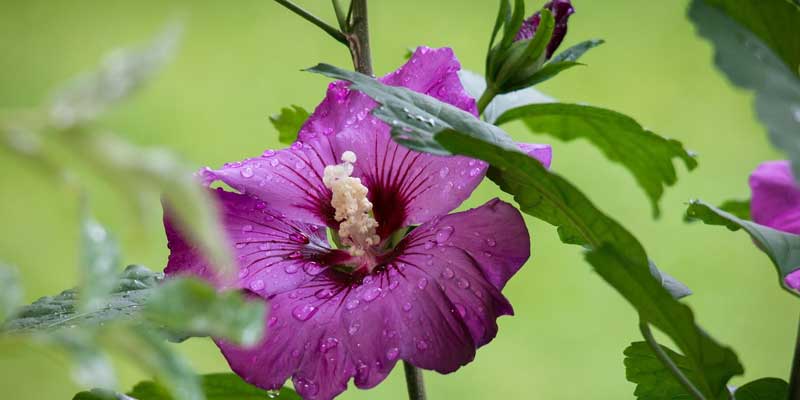Gardeners favor hibiscus for its striking blossoms and lush foliage, which infuse their landscapes with a tropical flair. Understanding the watering needs of these vibrant beauties is crucial for their thriving success. To water hibiscus effectively requires an intricate balance between art and science; it demands meticulous attention to environmental factors, soil conditions – even individual plant characteristics.
This comprehensive guide will delve into the factors that influence optimal watering frequency for your hibiscus plants, thereby ensuring their flourishing.
How Often To Water Hibiscus
Crucial for the health and vibrancy of hibiscus plants is appropriate watering: climate, soil type, planting method (container vs. ground), and plant size – all these factors along with humidity levels determine the frequency at which they need to be watered; generally—hibiscus prefer soil that is consistently moist yet well-draining.
Regularly monitor soil moisture, and when the need arises for watering, ensure deep penetration of the root zone. Base your adjustment in watering frequency on seasonal changes as well as plant response; aim to water in the morning so as to prevent fungal diseases. Provide proper care and attention: thus will hibiscus plants thrive – they shall reward you with abundant blooms and lush foliage.
5 Factors Influencing Watering Frequency
Several factors influence how often you should water your hibiscus plants:
1. Climate and Season
The climate in which your hibiscus thrives significantly influences its watering needs; specifically, the temperature and humidity levels dictate how often you should water.
In hot, arid regions where conditions lean towards dehydration, hibiscus necessitates more frequent hydration to maintain health as this is an important factor to consider when cultivating these plants.
In cooler and more humid climates, the need for frequent watering may decrease; seasonal variations also influence the frequency of watering.
During hot summer months, plants usually demand an increased amount of water – a requirement that diminishes during colder winter seasons.
2. Soil Type and Drainage
The soil type, along with its drainage properties, dictates the watering frequency of your hibiscus. A well-draining soil facilitates the escape of excess water; this prevents potential root rot by averting waterlogged conditions. Sandy or loamy soils drain more quickly than clay soils, necessitating more frequent watering.
3. Container Planting Versus Ground Planting
The way you choose to plant your hibiscus—whether it’s in a container or directly into the soil—directly affects the frequency at which you need to water it.
Limited soil volume in container-grown hibiscus plants, compared to their ground-dwelling counterparts, accelerates drying out. Hence, we must frequently water potted hibiscus – a necessity that intensifies during hotter weather.
4. Size and age
Your hibiscus plant’s size and age indeed affect its watering needs; however, you must note that young plants, as well as newly transplanted specimens, may demand more frequent watering. This is crucial during the phase of root system establishment.
Generally, larger and more established plants possess a superior water storage capacity; consequently, their need for frequent watering diminishes upon reaching maturity.
5. Humidity Levels
High humidity levels can diminish the rate of evaporation from soil and plant foliage, thereby influencing watering frequency. In regions characterized by high humidity, it might be necessary to recalibrate your watering schedule; less frequent irrigation could prevent over-saturation of soil.
Establishing a Watering Schedule
To maintain the optimal health and vigor of your hibiscus plants, you must create a watering schedule tailored to their specific needs. Here is a step-by-step guide:
1. Monitor Soil Moisture
Regularly monitor the soil moisture of your hibiscus plants: Assess the moisture level by inserting your finger into the soil near the base of each plant. If the soil feels dry to the touch, it’s time to water.
2. Water Deeply
Ensure your hibiscus receives thorough root zone penetration during watering. By encouraging deep soil penetration with ample amounts of water, you can promote not only the growth of robust roots but also enhance plant stability and resilience.
Avoid shallow, frequent watering, as this can lead to weak root systems.
3. Mulch
Apply a layer of organic mulch wood chips or straw, for instance around the base of your hibiscus plants; this action aids in retaining soil moisture, regulating soil temperature, and suppressing weed growth. This can reduce the frequency of watering required while promoting overall plant health.
4. Adjust for Seasonal Changes
Mind the seasonal variations in temperature and humidity; consequently, tailor your watering schedule. Throughout periods of high heat and low humidity – conditions that can induce moisture stress – you might need to increase the frequency of watering to prevent such strain.
In cooler, wetter seasons, scale back watering to avoid waterlogged soil.
5. Morning Watering
Whenever possible, ensure you administer water to your hibiscus plants in the morning; this practice facilitates drying of the foliage prior to the evening, a critical step that diminishes fungal disease risk.
Additionally, cooler morning temperatures minimize water loss through evaporation.
6. Monitor Plant Response
Vigilantly observe the response of your hibiscus plants to your watering techniques; overwatering may manifest in yellowed leaves, wilting, and root rot – while inadequate hydration could lead to drooping foliage and loss of flowers. Adjust your watering frequency based on your observations to ensure optimal plant health.
Conclusion
Understanding the factors that influence hibiscus plants’ watering needs and establishing a tailored schedule is essential for their overall health and vitality. Ensure your garden flourishes with vibrant blooms from thriving hibiscus plants by mastering this crucial task of maintaining optimal growing conditions by monitoring soil moisture; adjusting for seasonal changes, and paying close attention to how your plants respond to watering. Your meticulous care and attention will elicit a season-long display of vibrant flowers and luxuriant foliage from your hibiscus plants.



Leave a Reply